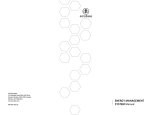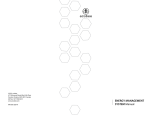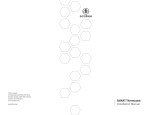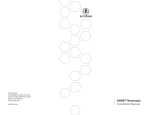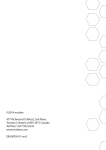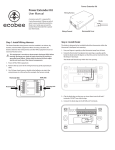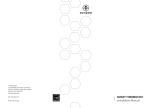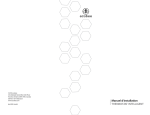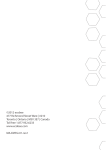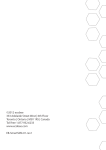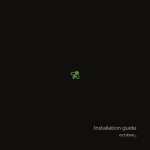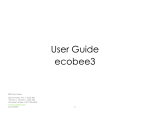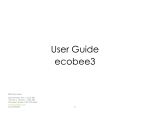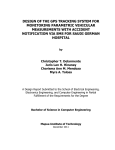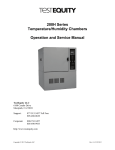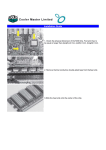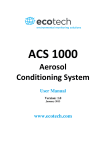Download EMS Manual
Transcript
© 2013 ecobee 477 Richmond St West | 2nd Floor, Toronto | Ontario | M5V 3E7 | Canada Toll free 1.877.932.6233 www.ecobee.com MA-EMS-203-R2 ENERGY MANAGEMENT SYSTEM Manual CONTENTS Getting Started 2 Welcome Technical Support Before You Begin HVAC System Compatibility Information FCC Compliance Statement Specifications Wiring Requirements 2 2 3 3 4 5 6 Installing the ecobee EMS 7 Step 1. Install the Equipment Interface Step 2. Connect the Equipment Interface to HVAC Equipment Step 3. Install the Thermostat Step 4. Connect the Thermostat to the Equipment Interface Step 5. Connect Power to Equipment Terminal Step 6. Check Equipment Interface Status LEDs 7 8 15 Navigating the Thermostat 19 Configuring the HVAC Settings 20 Installation Wizard Equipment Thresholds Test Equipment Sensors Remote Sensor Board Inputs View Wiring Diagram Technician Info Reset Installation Settings Reset All Settings Sales Demo Mode Reboot the Smart Thermostat Configuring Reminder Alerts Alerts 20 20 24 27 27 27 28 28 29 29 29 29 29 30 16 17 18 Automation 33 Setting up the Sensor Inputs 33 Connecting to the Internet 36 Setting Up WiFI Advanced Network Configuration 36 37 Creating an EMS Web Portal Account 38 Registering the EMS 38 Using the Thermostat 39 What’s on the Home Screen Cleaning the Touch Screen About Your Thermostat Viewing Details About Current Settings 39 41 41 41 Configuring Your Thermostat 44 Personalizing Your Thermostat Access Control Temperature Range Recovery Options Economizer Settings Thermostat Name Notes Utility CPP Settings Programming Your Thermostat Using the Wizard Using the Editor Scheduling a Vacation Event 39 45 46 46 47 47 47 48 49 50 51 52 Warranty 54 GETTING STARTED Welcome The ecobee Energy Management System (EMS) is the newest HVAC technology designed for the commercial market. It is ideal in applications where a simple programmable thermostat does not provide adequate controls or functionality, and a full-scale building automation system is too complex and cost prohibitive. The ecobee EMS is user-friendly, reduces a building’s operating costs, and delivers increased energy conservation. From their EMS Web Portal, users can remotely monitor, identify, analyze and troubleshoot performance issues; manage the temperature and operational settings from a central location; and take action without having to send a technician on-site. The ecobee EMS can maximize any building’s efficiency, reduce energy consumption and deliver significant cost savings. Key features of the ecobee EMS: Color touch screen display Precision +/- 1°F (0.5°C) temperature control Remote access via the Internet Vacation programming Seven-day programming Humidity monitoring and control Intelligent algorithms that adapt to your building and preferences Furnace fan control Ventilator control Quick Save function Two detector inputs Alerts and automated actions Technical Support Our technical support team is available to answer your questions at 1.877-9-ecobee (1.877.932.6233), or via email at [email protected]. 2 Before You Begin This product is intended to be installed by trained service professionals. This manual explains the procedures for installing the ecobee EMS. Please read it carefully before beginning the installation. The ecobee EMS consists of two parts: 1. ecobee 1. ecobee Thermostat – senses temperature, displays information and, if enabled, allows users to make adjustments directly on the touch screen. 2. Equipment Interface – provides power to the Thermostat and is the interface for all of the HVAC equipment. Caution: Disconnect electric power to the system before installing this product. Failure to do so could result in electric shock and/or equipment damage. ! All wiring must conform to your local electrical code. Mercury Notice: This product does not contain mercury. If you are replacing a product that does contain mercury, contact your local waste-management authority for disposal instructions. Do not discard the old product in the regular trash. 2. HVAC System Compatibility Information The ecobee EMS is designed to operate with lowvoltage heating and cooling systems. It is not designed for use with line-voltage or millivolt heating and cooling systems. 3 Getting Started Equipment Gas/Oil/Electric heating (up to three stages) Supported? Yes Heat pump with auxiliary heat (up to four stages) Yes Geothermal Heat Pump Yes Duel fuel systems Yes Standard electric cooling (up to two stages) Yes Boilers Yes Central humidifier Yes Central dehumidifier Yes Heat Recovery Ventilator (HRV) Yes Energy Recovery Ventilator (ERV) Yes Sensors with dry contact outputs Yes Approvals This product was designed and built in accordance to RoHS directive 2002/95/EC and contains no hazardous substances as defined by this directive. Optional Power supply meets EPA C.E.C Level IV and E.C CoC No Load power Consumption requirements. It is also safety approved to UL/cUL standards. FCC Compliance Statement This equipment has been tested and found to comply with the limits for Class B digital devices, pursuant to Part 15 of the FCC Rules. These limits are designed to provide reasonable protection against harmful interference in a residential installation. This equipment generates uses and can radiate radio frequency energy and, if not installed and used in accordance with the instruction manual, may cause harmful interference to radio communications. However, there is no guarantee that interference will not occur in a particular installation. If this equipment does cause harmful interference to radio or television reception, which can be determined by turning the equipment off and on, the user is encouraged to try to correct the interference by one or more of the following measures: Getting Started 4 Reorient or relocate the receiving antenna Increase the separation between the equipment and receiver Connect the equipment to an outlet on a different circuit from the receiver Consult the dealer or an experienced radio/TV contractor for help. Warning: Changes or modifications not expressly approved by ecobee Inc. could void the user’s authority to operate the equipment. To satisfy FCC/IC RF exposure safety requirements, a separation distance of 20 cm or more should be maintained between this device and persons. To ensure compliance, operation at closer than this distance is not allowed. FCC ID: WR9EBSTAT IC: 7981A-EBSTAT Specifications Temperature ranges Heat: 45 to 79 °F (7 to 26 °C) Cool: 58 to 92 °F (14 to 33 °C) Display: 40 to 100°F (5 to 37 °C) Sensitivity: +/- 1 °F (0.5 °C) Equipment Interface Operating: –40 to 160 oF (–40 to 70 oC) Thermostat Operating: 32 to 130oF (0 to 55 oC) Humidity Range Humidify: 20 to 50% R.H Dehumidify: 30 to 60% R.H Display: 0 to 90% R.H Sensitivity: +/- 2% R.H. Operating: 5 to 95% R.H non-condensing Dimensions Thermostat: 5.5”W x 3.25”H x 1”D (139.5mm H x 82.5mm W x 25mm D) Equipment Interface: 4.6”W x 10”H x 1.3”D (118mm W x 254mm H x 32mm D) Power AC Transformer: 24 VAC 3VA Minimum (not included) Battery: CR2032 3V lithium coin cell (included), Power Adaptor: #EB-PS-01 120V 50/60Hz to 12 VDC 1A (not included) 5 Getting Started Wiring Requirements The following table shows the maximum wire lengths allowed: Thermostat to Equipment Interface 18 AWG 20 AWG 22 AWG 1250 ft/380 m 790 ft/240 m 500 ft/150 m Equipment Interface to HVAC Equipment 18 AWG 20 AWG 22 AWG 128 ft/39 m 80 ft/24 m 50 ft/15 m Terminal Description and Electrical Ratings Terminal Description Voltage Current max Y 1st stage cooling 30V AC 3A W (O/B) 1st stage heating (or changeover) 30V AC 3A G Fan 30V AC 3A W2 (AUX) 2nd stage heating (or 1st auxiliary heat) 30V AC 3A R/H Heat transformer return 30V AC 3A R/C Cool transformer return 30V AC 3A ACC1 1st accessory relay 30V AC 3A ACC1r 1st accessory relay return 30V AC 3A ACC2 2nd accessory relay 30V AC 3A ACC2r 2nd accessory relay return 30V AC 3A ACC3 3rd accessory relay 30V AC 3A ACC3r 3rd accessory relay return 30V AC 3A IN1+ Input 1 + Dry contact only Dry contact only IN1- Input 1 - Dry contact only Dry contact only IN2+ Input 2 + Dry contact only Dry contact only IN2- Input 2 - Dry contact only Dry contact only +12V 12V DC power to thermostat GND GND to thermostat - - D+ Data + communication line - - D- Data – communication line - - 8 to 14V DC 600mA Getting Started 6 INSTALLING THE ECOBEE EMS There are 5 steps to install the ecobee EMS: Step 1: Install the Equipment Interface. Step 2: Wire the Equipment Interface. Step 3: Install the Thermostat. Step 4: Connect the Thermostat to the Equipment Interface. Step 5: Power up both devices. Step 1. Install the Equipment Interface To install the Equipment Interface: 1. Select a suitable location. Make sure the surface is relatively flat and, if you are using a power adaptor, make sure there is an electrical outlet within five feet of where you plan to mount the device. 2. Remove the front cover of the Equipment Interface. If necessary, insert a flat-head screwdriver into one of the slots as shown below, and gently twist the screwdriver. 3. Place the back of the enclosure on the intended mounting surface and use it as a template to mark the location of the mounting holes, as shown below. Insert a screwdriver into one of the two slots and twist gently 7 Installing the ecobee EMS Mounting holes indicated with solid color 4. Move the back of the enclosure out of the way and make the holes where indicated in step 3. The mounting holes can accommodate a #6 pan-head screw. 5. Use drywall plugs or other screw anchors (not included) to ensure the Equipment Interface can be mounted securely. 6. Fasten the backplate to the wall using the appropriate screws (not included). Step 2. Connect the Equipment Interface to HVAC Equipment To connect the Equipment Interface to the HVAC equipment: 1. Disconnect the power to the heating and air conditioning equipment. 2. Disconnect the wires going to the existing thermostat. 3. Using the wiring diagrams on pages 9-14, connect the heating or air conditioning equipment to the Equipment Interface. 4. Do not apply power to the Equipment Interface at this time. 5. Do not re-attach the front cover at this time. Installing the ecobee EMS 8 Equipment Interface Terminals The Equipment Interface Module has the following terminals. Note: There is a factory installed jumper between R/H and R/C. 24 Vac Power System Line Communications Y W O/B G W2 AUX R/H R/C NC NC ACC1 ACC1r IN2IN2+ ACC2 ACC2r ACC3 ACC3r IN1IN1+ DD+ GND +12V Wiring Diagrams Single Stage With 3 Accessories The following diagrams show how to connect theHeat/Cool Equipment Interface terminals to various HVAC equipment. Equipment Interface Y W O/B G W2 AUX R/H R/C HRV Dehumidifier Humidifier Furnace Y W G R Hum C Air Conditioner 24V C Humidifier 24V C HRV ACC1 ACC1r 24V C ACC2 ACC2r ACC3 ACC3r Dehumidifier 24V C Single Stage Heat/Cool with Three Accessories NOTE 9 factory installed jumper. Non Powered Accessories will require a jumper from RH | RC to ACC1, ACC2, ACC3 for a 24V feed. Diagram indicates 24V humidifier terminal. If your furnace control board does not have this, you must use a 110V/24V step down transformer. Installing the ecobee EMS Two Stage Heat/ Single Stage Cool With 3 Accessories Equipment Interface Y W O/B G W2 AUX R/H R/C HRV Dehumidifier Humidifier Furnace Air Conditioner Y1 W1 G W2 R Y2 Hum C 24V C Humidifier 24V C HRV ACC1 ACC1r 24V C ACC2 ACC2r ACC3 ACC3r Dehumidifier 24V C Dual Stage Heat, Single Stage Cool with Three Accessories NOTE Non Powered Accessories will require a jumper from RH | RC to ACC1, ACC2, ACC3 for a 24V feed. factory installed jumper. Diagram indicates 24V humidifier terminal. If your furnace control board does not have this, you must use a 110V/24V step down transformer. Two Stage Heat/Cool With 2 Accessories Equipment Interface Y W O/B G W2 AUX R/H R/C HRV Comp2 Humidifier Furnace Air Conditioner Y1 Y2 R C Y1 W1 G W2 R Y2 Hum C Humidifier 24V C ACC1 ACC1r HRV ACC2 ACC2r ACC3 ACC3r 24V C indicates a jumper. Non-powered accessories require a jumper from RH / RC to ACC1, ACC2, ACC3 for a 24V feed. NOTE Indicates jumper. Non Powered Accessories will require a jumper from RH | RC to ACC1, ACC2, ACC3 for a 24V feed. factory installed jumper. Dual Stage Heat/Cool with Two Accessories Diagram indicates 24V humidifier terminal. If your furnace control board does not have this, you must use a 110V/24V step down transformer. Installing the ecobee EMS 10 Three Stage Heat 2 Stage Cool With 1 Accessories Equipment Interface Furnace Y1 W1 G W2 R Y2 W3 Hum C Y W O/B G W2 AUX R/H R/C 3rd Stage Heat 2nd Stage Cool Humidifier ACC1 ACC1r Air Conditioner Y1 Y2 R C Humidifier 24V C ACC2 ACC2r ACC3 ACC3r indicates a jumper. Non-powered accessories require a jumper from RH / RC to ACC1, ACC2, ACC3 for a 24V feed. NOTE Indicates jumper. Non Powered Accessories will require a jumper from RH | RC to ACC1, ACC2, ACC3 for a 24V feed. factory installed jumper. Three Stage Heat, Two Stage Cool with One Accessory Diagram indicates 24V humidifier terminal. If your furnace control board does not have this, you must use a 110V/24V step down transformer. 1 Stage Heat/Cool With 2 Stage Auxiliary Heat (Duel Fuel) With Humidifier Accessory Equipment Interface Y W O/B G W2 AUX R/H R/C Aux Heat Stage 2 Humidifier Fan Coil O W2 W1 Y/Y2 G R C 1-Speed Heat Pump O W2 Y R C ACC1 ACC1r ACC2 ACC2r ACC3 ACC3r Humidifier C 24V 24V C C 110V CONFIGURE ACC2 - Emerg Heat 2 | ACC3 - Humidifier NOTE 11 Single Stage Heat/Cool , Dual Stage Auxiliary Heat with Humidifer Indicates jumper. Non Powered Accessories will require a jumper from RH | RC to ACC1, ACC2, ACC3 for a 24V feed. factory installed jumper. Installing the ecobee EMS Two Stage Heat/Cool With 1 Stage Auxiliary Heat (Duel Fuel) with 2 Accessories Equipment Interface Y W O/B G W2 AUX R/H R/C Furnace Heat Pump Y W G R Hum C O Y1 W2 Y2 R C Humidifier HRV Comp2 Humidifier NOTE ACC1 ACC1r 24V C ACC2 ACC2r ACC3 ACC3r HRV 24V C indicates a jumper. Non-powered accessories require a jumper from RH / RC to ACC1, ACC2, ACC3 for a 24V feed. Indicates jumper. Non Powered Accessories will require a jumper from RH | RC to ACC1, ACC2, ACC3 for a 24V feed. factory installed jumper. Diagram indicates 24V humidifier terminal. If your furnace control board does not have this, you must use a 110V/24V step down transformer. Dual Stage Heat/Cool, Single Stage Auxiliary Heat with Two Accessories Two Stage Heat/Cool Two Stage Auxiliary Heat (Duel Fuel) With One Accessory Equipment Interface Y W O/B G W2 AUX R/H R/C Aux Heat Stage 2 Comp2 Humidifier Heat Pump Furnace Y1 W1 G W2 R Y2 Hum C O Y1 W2 Y2 R C Humidifier 24V ACC1 ACC1r C ACC2 ACC2r ACC3 ACC3r indicates a jumper. Non-powered accessories require a jumper from RH / RC to ACC1, ACC2, ACC3 for a 24V feed. NOTE Indicates jumper. Non Powered Accessories will require a jumper from RH | RC to ACC1, ACC2, ACC3 for a 24V feed. factory installed jumper. Diagram indicates 24V humidifier terminal. If your furnace control board does not have this, you must use a 110V/24V step down transformer. Dual Stage Heat/Cool, Dual Stage Auxiliary Heat with One Accessory Installing the ecobee EMS 12 Two Stage Furnace (Carrier 58MVB) With Two Stage Heat Pump (Duel Fuel) Equipment Interface Y W O/B G W2 AUX R/H R/C Aux Heat Stage 2 Comp2 Dehumidifier NOTE ACC1 ACC1r Furnace Heat Pump W2 Y1 W/W2 Y/Y2 G R O Y1 W2 Y2 R C Dhum Com Hum Humidifier 24V C ACC2 ACC2r ACC3 ACC3r Humidastat Indicates jumper. Non Powered Accessories will require a jumper from RH | RC to ACC1, ACC2, ACC3 for a 24V feed. factory installed jumper. indicates a jumper. Non-powered accessories require a jumper from RH / RC to ACC1, ACC2, ACC3 for a 24V feed. Diagram indicates 24V humidifier terminal. If your furnace control board does not have this, you must use a 110V/24V step down transformer. Dual Transformer – Single Stage Cooling With Boiler Dual Stage Furnace with Dehumidifier and Two Stage Heat Pump Equipment Interface Y W O/B G W2 AUX R/H Fan Coil Air Conditioner Y G R C 24V C Boiler R C W R/C ACC1 ACC1r ACC2 ACC2r ACC3 ACC3r Note: Remove factory installed jumper NOTE 13 factory installed jumper must be removed for this configuration. Non Powered Accessories will require a jumper from RH | RC to ACC1, ACC2, ACC3 for a 24V feed. Installing the ecobee EMS Single Stage Cooling with Boiler Dual Transformer – Dual Stage Cooling With Boiler Equipment Interface Fan Coil Air Conditioner Y1 Y2 G R C Y W O/B G W2 AUX R/H Y1 Y2 R C Boiler R/C Comp 2 R C ACC1 ACC1r W ACC2 ACC2r ACC3 ACC3r NOTE indicates a jumper. Non-powered accessories require a jumper from RH / RC to ACC1, ACC2, ACC3 for a 24V feed. factory installed jumper must be removed for this configuration. Non Powered Accessories will require a jumper from RH | RC to ACC1, ACC2, ACC3 for a 24V feed. Note: Remove factory installed jumper Dual Stage Cooling with Boiler Installing the ecobee EMS 14 Step 3. Install the Thermostat The ideal location for the Thermostat is approximately five feet (1.5m) above floor level in the main living area. Do not install the Thermostat: Close to sources of heat such as incandescent lights Near heating/cooling registers In direct sunlight On exterior, non-insulated or poorly insulated walls In the kitchen or other areas of potentially high heat and/or humidity In an area that could restrict air flow To install the Thermostat: 1. Remove the front cover of the Thermostat. Insert a flat-head screwdriver into one of the slots as shown below and gently twist the screwdriver. Insert screwdriver into one of the two slots and twist gently 2. Place the Thermostat backplate on the wall. Make sure that any existing wires can be inserted through the opening for the wiring. 3. Using the backplate as a template, mark the location of the mounting holes on the wall as shown below. D- D+ GND +12V The solid color indicates mounting holes 15 Installing the ecobee EMS 4. Move the backplate out of the way and make holes where indicated in step 3. The mounting holes can accommodate a #6 pan-head screw. Use drywall plugs or other screw anchors (not included) to ensure the Thermostat can be mounted securely to the wall. 5. Fasten the backplate to the wall using the appropriate screws (not included). Step 4. Connect the Thermostat to the Equipment Interface Only four wires (D-, D+. GND, +12V) are needed to connect the Thermostat to the Equipment Interface. If you are replacing an existing thermostat, you can use the existing wiring. Note: Ensure any unused wires do not have exposed bare copper conductors. To connect the Thermostat to the Equipment Interface: 1. Connect the wires as shown below. DD+ GND Equipment Interface +12V D- D+ GND +12V Thermostat Wiring from Smart Thermostat to the Equipment Interface 2. Attach the front cover of the Thermostat to the backplate. Ensure the four pins on the circuit board mate with the terminal block on the backplate as shown below. Replace the front cover ensuring the pins meet the terminals Installing the ecobee EMS 16 + Note the small clips on the edge of the battery encasing. Slide the battery under the contacts and push down firmly Push down on the battery firmly until it snaps into place. Slide the battery UNDER the clips. The Thermostat comes with a factory installed, coin cell battery. When replacing the battery, ensure the + side of the battery is facing out and the battery contacts remain in the upright position (not bent underneath the battery). The battery should snap in easily. Step 5. Connect Power to Equipment Terminal You can now apply power to the Equipment Interface and restore power to the heating and air conditioning equipment. There are two methods of powering the Equipment Interface. You can power it directly from a 24VAC source capable of at least 3VA. 24 Vac 24Vac | 3VA min Hard-wired 24 VAC option The second method requires the optional 120V to 12V DC power adaptor. Plug the power supply into a standard electrical outlet and plug the barrel connector into the Equipment Interface. Plug the adaptor into the Equipment Interface Note: The Thermostat receives power from the Equipment Terminal. You do not plug it in to a wall outlet. 17 Installing the ecobee EMS Step 6. Check Equipment Interface Status LEDs The Equipment Interface has four LEDs to display the status of the system. If you’ve wired the system correctly, only the Power LED should be on. Power System Line Communication Equipment Interface LEDs Power – Monitors the power supply of the Equipment Interface: LED ON Equipment Interface is receiving power within the appropriate voltage range. LED OFF Power is disconnected or has dropped below 9V. System – Monitors the operation of the Equipment Interface: LED ON There is a fault with the Equipment Interface. LED OFF The equipment interface is operational. Line – Monitors the power supplied to the Thermostat from the Equipment Interface. LED ON Voltage at the +12V and GND terminal has dropped below 7V. LED OFF Adequate power is being supplied to the Thermostat. Communication – Monitors the communication between the Thermostat and the Equipment Interface (D+ and D- terminals). LED ON The Equipment Interface and Thermostat are not communicating with each other. LED OFF The two devices are communicating properly. Installing the ecobee EMS 18 NAVIGATING THE THERMOSTAT Once the Thermostat and Equipment Interface are powered up and working correctly, you can configure the system. The Thermostat uses touch screen technology, so it’s easy to navigate – just tap the icons, buttons and lists. Note: To prevent damage to the touch screen, never use a sharp object such as a pen. When an option has an arrow on the right, it indicates there are more than two options to choose from. If there is no arrow, then the list item only has two options. Toggle between options by pressing the toggle. Press Done to save changes and move to the next screen. Press Cancel to go back to the previous screen without saving changes. Home Button At any time, press the Home button (the physical button found on the right-hand side of the touch screen). This cancels any action and takes you back to the home screen. On-Screen Keyboard If you need to type in any information, an on-screen keyboard will appear. Press the Caps key to enter capital letters; press the 123@ key to enter numbers or commonly used symbols. 19 Navigating The Thermostat CONFIGURING THE HVAC SETTINGS The first step after installing the ecobee EMS is to configure the settings for the various devices (such as a furnace, air conditioner, humidifier, dehumidifier or ventilator) that are connected to the Equipment Interface. Installation Wizard The Installation Wizard takes you step-by-step through a series of choices regarding the HVAC equipment. Answer the questions accordingly and press Next to advance to the next screen. Once completed, you will be shown a wiring diagram that reflects your choices. You can press Back to go back and make any changes. Once you are satisfied with the setup, press Done. The wiring diagram should be the same as the wiring you did during the Equipment Terminal installation (pages 8–14). To configure the installation settings: From the Home screen, press More. Press Settings and select Installation Settings Equipment The Equipment setting lets you to manually configure the devices connected to the Equipment Interface. Heat Pump This section lets you configure a 1 or 2-stage heat pump. If a second stage is required you must configure an Accessory relay to control that stage. Geothermal/ground source heat pump Select Yes if you are using a geothermal or ground source heat pump. This helps the thermostat determine optimum performance and default settings. If you select No, the system will optimize the settings for an air-to-air heat pump. OB Energize on cool If you choose Yes, the reversing valve output (O/B terminal) will activate when there is a call for cooling. If you select No, the relay will energize when there is call for heat. Min Cycle Off Time Configures the compressor off time between cycles (240 to 900 seconds). Min Outdoor Temp Disables the compressor when the outside air temperature reaches the configured Configuring the HVAC Settings 20 minimum setting. This performs two functions. It prevents the compressor from running when the outdoor temperature is too low, thus resulting in damage to the compressor. You can also set this value to determine when you want the auxiliary heat (if installed) to engage to help meet the set temperature. The temperature range is adjustable from 0 to 65 °F (–17.8 to 18.3 °C) or can be completely disabled. Note: You need an internet connection for this feature to operate properly. Allow heat pump and auxiliary heat to run simultaneously If you select Yes and there is a source of auxiliary heat, it will turn on in addition to the heat pump. The heat pump will be energized for the first 30 minutes. If, after 30 minutes, the set point has not been met, the auxiliary heat will be energized to assist the heat pump in meeting the load. If you select No, the heat pump will be energized for up to 2 hours. If after 2 hours the set point has not been met, the thermostat will shutdown the heat pump and energize the auxiliary heat to meet the set point. This option should also be used for installation where the heat pump evaporator coil is downstream from the source of auxiliary heat. Furnace/Auxiliary Heat Allows you to enable and configure up to a 3-stage conventional heat source. If you have selected a heat pump as your primary source, this feature allows you to configure the auxiliary heat connected to the system. Furnace Type Allows you to configure the type of furnace. This helps the thermostat optimize its algorithms based on the type of fuel and typical characteristics of the chosen system. Choose the option that best represents the type of heating system installed. Heat Stages Allows you to configure up to 3 stages of heat. If you require a third stage, you must configure an accessory relay to control that stage. Heat Fan Control Configures the furnace fan to be 21 Configuring the HVAC Settings controlled by the HVAC system during heat cycles or by the thermostat. Normally the HVAC system controls the fan during heat cycles. Air Conditioner Configures up to 2 stages of air conditioning. If you require a second stage, you must configure an accessory relay to control that stage. Staging Method of Operation The ecobee Thermostat uses a unique method for staging multi-stage heating or cooling. It uses a combination of intelligent algorithms and past performance to determine when to activate the stages. When there is a call for heat or cool, the system computes how long it would take for the system to reach the desired set point in stage 1, stage 2 or stage 3 accordingly. It will determine the highest stage at which a minimum of 10 minutes of run time is required. It will then automatically start the system at that stage (i.e. if it calculates that it will take 15 minutes at stage 2 but only 7 minutes at stage 3, the system will immediately turn on stage 2 to meet the set point). If the calculation indicates to start at stage 1, and it takes more than 10 minutes to reach the set point, it will automatically engage stage 2. If stage 2 runs for more than 10 minute without reaching the set point it will activate stage 3. A minimum run time of 10 minutes is used to ensure that proper circulation throughout the system and that minimum cycle times are maintained. For heat pumps with auxiliary heat, the operation of the auxiliary heat will depend on the configuration of the Allow Heat Pump/Auxiliary Heat to Run Simultaneously. Accessory relays Accessory relays (ACC) are generic relays that can be configured to control the following: Heat Stage 3 Select this option when the thermostat is required to control a 3-stage conventional heating system. Connect the third stage (or W3) contact to this accessory relay. Auxiliary Heat Stage 2 Select this option when the thermostat is required to control a heat pump system with 2 stages of Auxiliary heat. Connect the second stage of the auxiliary heat to this relay. Compressor/AC Stage 2 Select this option when the Configuring the HVAC Settings 22 thermostat is required to control either a 2 stage heat pump or a 2 stage air conditioner. Connect the Y2 terminal of the system to this relay. Humidifier Select this option when the thermostat is required to control a humidifier. When this option is selected you will also be able to configure the following: Humidify only while heating Choose Yes to only activate this relay when the current humidity is below the humidity set point and there is a call for heat. Choose No to activate this relay and the system fan when the current humidity is below the humidity set point (designed to support steam-type humidifiers). Min Runtime Delta Determines the minimum time the system will run from the set point in order to reduce short cycling of the equipment. Window Efficiency To optimize frost control, the system needs to know the efficiency ratio of the windows within the area being controlled: Low, Medium and High. Dehumidifier On a call for cool, if the current humidity is above the set point, this relay will be activated. Dehumidity with Fan Configures fan operation during the dehumidification cycle. Choose Yes if you are using the air conditioning system to dehumidify; choose No if you are using a standalone dehumidification system that independently controls the system fan. Min Runtime Delta Determines how far from the set point, the system will maintain to reduce short cycling of the equipment. Dehumidify in Heat Mode Allows you to control the dehumidification even when the system is in heat mode. Dehumidifier Active Allow you to configure if the active state of this relay is open or closed. Ventilator Activated when the user engages Ventilator Max from the Details screen. The system fan will also turn on when Ventilator Max is engaged 23 Configuring the HVAC Settings Thresholds This section configures the temperature and time thresholds associated with the heating and cooling equipment. You must configure the Equipment settings (pages 20–23) before setting the thresholds. Only the application thresholds are be shown (i.e. if no air conditioner is configured, you will not see the options related to air conditioners). Allow Auto Heat/Cool Enable this option to allow the user to select auto change-over as a system mode. Heat/Cool Min Delta The minimum difference between the heat mode set temperature and the cool mode set temperature when the system mode is in auto change-over. Compressor Settings Min Cycle Off Time Configures the compressor off time between cycles. This ensures the compressor does not short cycle (which could affect the operating life of the system). This is adjustable from 240–900 seconds. Min Outdoor Temp Configures the minimum outside air temperature at which the compressor will be disabled. This performs two functions. It prevents the compressor from running when the outdoor temperature is too low, thus resulting in damage to the compressor. You can also set this value to determine when you want the auxiliary heat (if installed) to engage to help meet the set temperature. The temperature range is adjustable from 0 to 65 °F (–17.8 to 18.3 °C) or can be completely disabled. Note: You need an internet connection for this feature to operate properly. AC Overcool Max When using the AC to dehumidify, the setting configures how many degrees below the current set point the thermostat will run in order to reach the dehumidify set point. Configuring the HVAC Settings 24 Aux Heat Settings Max Outdoor Temperature Configures the maximum outdoor temperature threshold. Above this level, the auxiliary heat will not be activated. Instead, the heat pump will maintain the set point. Common Heat/Cool Settings Heat Differential Temp The minimum difference between the current temperature and set temperature before the system calls for heat. A smaller difference means a more comfortable environment, whereas a larger difference is more economical. Heat Dissipation Time The amount of time the fan will run after the heat set point has been reached and the call for heat has been turned off. Running the fan for a period of time allows for any heated air left in the ducts to circulate throughout the home. Cool Differential Temp The minimum difference between the current temperature and the set temperature. Cool Dissipation Time The amount of time the fan will run after the cool has been turned off. Running the fan for a period of time allows for any cooled air left in the ducts to circulate throughout the home. Advanced Settings These options customize how long each stage will run before the next stage turns on. You may also program when a particular stage is turned on based on the temperature delta between the set temperature and the current temperature. Reverse Staging If enabled, the thermostat will cycle down from the higher stages so that as it approaches set point it will only be running in stage 1. The HVAC equipment will start in stage 1. As the stage 1 temperature delta is exceeded, the second stage will engage. Once the equipment has brought the current temperature back to within the temperature delta, stage 2 will disengage and stage 1 remain running until the set point is meet. 25 Configuring the HVAC Settings Stage X Max Runtime The maximum amount of time X stage will run before engaging the next stage. Options are Auto and 10-120 minutes Stage X Temp Delta The minimum difference between the current temperature and the set temperature that will activate this stage (regardless if the maximum run time of the previous stage was reached). Options are Auto and 1 to 10 °F (0.6 to 5.6°C). Comp to Aux Runtime The maximum amount of time this stage will run before engaging the next stage. Options are Auto and 10 to 180 minutes Comp to Aux Temp Delta The minimum difference between the current temperature and the set temperature that will activate this stage (regardless if the maximum run time of the previous stage was reached). Options are Auto and 1 to 10 °F (0.6 to 5.6°C). Cool Min On Time Sets the minimum equipment run time in cool mode: 1 to 20 min (default is 5 min) Heat Min On Time Sets the minimum equipment run time in heat mode: 1 to 20 min (default is 5 min) Temp Correction Lets you program an offset between the real temperature at thermostat and the displayed temperature. If you find that the temperature where the thermostat is located does not represent the room temperature, change the offset compensate for the difference. Installer Code To prevent accidental modifications to the installation settings, you can enable a 4-digit installer code. This code is pre-programmed to 3262. Configuring the HVAC Settings 26 Test Equipment These options let you test the wiring and connections of the devices connected to the Equipment Interface by turning them on or off. If a Remote Sensor module is installed (optional), this section will display the actual value (in ohms or volts) being read for each individual sensor. The equipment will turn off when you select Done. ! Warning: Compressor protection and minimum run-time features are not enforced while in this mode. Sensors These options configure the detector inputs on the Equipment Interface. They can be used to connect optional flood sensors or other leak-detection devices. Once an input has been triggered, it will generate an alert on the touch screen and send an e-mail (if the thermostat is registered). Each input can be configured as Normally Open, where a short-circuit between the IN1+ and IN1 will activate the alert, or Normally Closed, where an open circuit will activate the alert. To activate any input, select the input and program a name. To deactivate the input, simply delete the name. Remote Sensor Board Inputs (EB-RSM only) These settings are for thermostats configured with the optional EB-RSM Remote Sensor Board. Name To enable, simply enter a name for this input (i.e. Door sensor). To disable this input delete the name assigned. Type Defines the type of input. Configure Choose from a predetermined list of commonly available sensors. If your sensor is not on the list you can create a new one by entering the specific parameters. For Temperature sensors, you need the B value of the sensor or the resistance value of the sensor at 70 °F (21°C). These are found on the sensor manufacturers data sheet. Note: Only 10K NTC type temperature sensors are supported. 27 Configuring the HVAC Settings Usage These options configure the sensor’s function: Control Sensor Configures the sensor to be part of the HVAC control. The sensor can then be configured to replace or be part of a the Thermostat Set temperature. Refer to page 27 in the User Manual to configure Set Temperature Average. Monitoring Sensor Configures the sensor to monitor areas independent of the HVAC system (e.g. freezers, wine cellars etc). Outdoor Sensor Allows you to use an outdoor temperature sensor in place of the internet weather feed. The measured value will be used for any control or dual fuel algorithms and will be displayed on the thermostat. The thermostat will continue to use the internet weather feed for the 5-day forecast. View Wiring Diagram This feature allows you to view the terminal connections of the equipment interface as determined by the configuration options selected during the installation process. Technician Info Use this section to enter your contact information. The information will be displayed to the homeowner in the About menu, when any alert is shown on the touch screen, and in his or her personal web portal. You can enter your: Company name Phone number Email address Website address. If you are a registered ecobee contractor, you can enter the the serial number of each ecobee EMS you install in the ecobee Contractor portal. When any of registered thermostats are connected to the Internet, your contact information, including your company logo, will be automatically loaded onto them. Configuring the HVAC Settings 28 Reset Installation Settings Restores all installation (e.g. equipment) settings back to the factory default. Any user setting (not related to the equipment configuration) will remain unchanged. Reset All Settings Reset the entire EMS system back to its original factory default settings. Performing a Hardware Reset In rare circumstances, static electricity or power surges may interrupt the operation of the Thermostat or Equipment Interface, forcing a hardware reset. Sales Demo Mode Places the Thermostat into a demostration mode. Select this option again to return it to normal operation. Reboot the Thermostat You can reboot the Thermostat by pressing the hardware reset button, located through an opening in the top left corner of the Thermostat. Rebooting will not alter programming or configuration options. Reset button indicated in solid colour Configuring Reminder Alerts To configure reminder alerts: From the Home screen, press More. Press Settings and select Reminders and Alerts. The Reminders and Alerts list displays the reminders and alerts described below. Use the scroll bar at the right of the list to see all the settings. Note: If a humidifier, dehumidifier or ventilator is not configured in Accessory Relays, these options will not be displayed. HVAC Maintenance The HVAC Maintenance reminder generates an alert telling the homeowner that regularly scheduled maintenance is required. 29 Configuring the HVAC Settings This alert, along with technician contact information can be displayed on the touch screen. If the homeowner registers the thermostat, the reminder will be emailed to them and be displayed in the web portal. You can set the Last Service date, turn the Reminder On or Off, and to set the Frequency of the maintenance interval in months. Furnace Filter Generates an alert for cleaning or changing the filter. You can set the Last Filter Change date, turn the Reminder On or Off, and set the Frequency of the maintenance interval. Humidity Filter Generates an alert for cleaning or changing the filter. You can set the Last Filter Change date, turn the Reminder On or Off, and set the Frequency of the maintenance interval. Dehumidifier Filter Generates an alert for cleaning or changing the filter. You can set the Last Filter Change date, turn the Reminder On or Off, and set the Frequency of the maintenance interval. Ventilator Filter Generates an alert for cleaning or changing the filter. You can set the Last Filter Change date, turn the Reminder On or Off, and set the Frequency of the maintenance interval. UV Lamp Sets the reminder period for cleaning or replacing a UV lamp. You can set the Last Lamp Change date, turn the Reminder On or Off, and set the Frequency of the maintenance interval. Alerts The Thermostat can generate alerts if the temperature in the home reaches a pre-programmed level. This protects the home from damage due to freezing and/or excessive heat. This alert, along with optional technician contact information will be displayed on the touch screen. If the homeowner registers the thermostat, the alert will be emailed to them and be displayed in thee web portal. Configuring the HVAC Settings 30 Low Temperature Alert Sets the temperature at which the Thermostat will generate a Low Temperature Alert. The range can be: Off – no alert will be generated Set temperature range of 35 to 68 °F (1.5 to 20 °C). High Temperature Alert Sets the temperature at which the Thermostat will generate a High Temperature Alert. The range can be: Off – no alert will be generated Set temperature range of 76 to 104 °F (24.5 to 40 °C). Low Humidity Alert Sets the humidity level at which the Thermostat will generate a Low Humidity alert. The range can be adjusted to: Off – no alert will be generated Set humidity range of 5 to 95% R.H. in 5% increments High Humidity Alert Select this item to set the humidity level at which the Thermostat will generate a High Humidity alert. The range can be adjusted to: Off – no alert will be generated Set humidity range of 5-95% R.H. in 5% increments Auxiliary Heat Run-time Alert (optional) If a heat pump with auxiliary heat is configured, you can program the Thermostat to generate an alert if the auxiliary heat runs for more than this programmed amount of time during a 24-hour period. Auxiliary Outdoor Temperature Alert (optional) If a heat pump with auxiliary heat is configured, you can program the Thermostat to generate an alert if the auxiliary heat is called for when the outdoor temperature exceeds this programmed set point (this feature requires an internet connection to function properly). Enable Alerts to be displayed on console Select No if you do not want any of the alerts to be display on the touch screen. Alerts will continue to be displayed on the web portal and sent via email. Enable Heating and Cooling Alerts Select No to disable alerts for heat/cool error conditions. If disabled, the alerts will not be appear in the touch screen, web portal or emails. 31 Configuring the HVAC Settings List of Alerts Below is a complete list of alerts. Depending on your configuration, some of these may not apply. Low Battery Battery in thermostat needs to be changed (see page 17). Furnace Air Filter Furnace filter needs to be cleaned or changed. Ventilator Filter Ventilator filter needs to be cleaned or changed. UV Lamp UV lamp needs to be changed. Humidifier Filter Humidifier pad needs to be cleaned or changed. Comms fault There is no communication between the Smart Thermostat and the Equipment Interface. Make sure the Equipment Terminal is powered on and is connected to the Smarth Thermostat. Low Temp. Alert Temperature in the home is too low. High Temp Alert Temperature in the home is too high. Low Humidity Alert Humidity in the home is too low. High Humidity Alert Humidity in the home is too high. Heat Not Responding Heating system is malfunctioning. Cool Not Responding Cooling system is malfunctioning. Input 1 Input 1 alert condition (if configured) Input 2 Input 2 alert condition (if configured) Maintenance Reminder HVAC system due for regular maintenance. Auxiliary Heat Run Time Auxiliary heat source is running too often. Auxiliary Outdoor Temperature Your auxiliary heat source is running at a higher temperature than the expected outdoor temperature. Configuring the HVAC Settings 32 AUTOMATION The ecobee EMS can be configured to perform actions based on the status of its 2 dry contact inputs. You can have multiple actions per input. You can also have the same input perform different actions when it is open or closed. Setting Up the Sensor Inputs To configure Sensor Inputs: From the Home screen, press More. Press Settings and select Installation Settings. Select Sensors. To Add a New Sensor state: Select the Dry Contact associated with the Sensor. Give the Sensor state a Name then select Configure States. The ecobee EMS system supports 2 dry contact inputs (IN1 and IN2). In order to use them, you need to ensure they are wired correctly in the Equipment Terminal and are configured in the Thermostat. Name To enable, simply enter a name for this input (i.e. Door sensor). To disable this input, delete the name. Type Defines the type of input (only Dry Contacts are supported in this version). Configure States Lets you to view, edit or Add New State. State Configure if the circuit (contact) is open or closed. Configure Actions This section allows you to program and edit the actions or Add New Action. Type Select the action to perform from the list: Enter the chosen State, open or closed, then Select Configure Actions. Do Nothing No specific action will occur if this option is selected. Enter all applicable info including the type of action you would like performed for this state. Unoccupied* Switches the system to the Unoccupied program when the input is activated. Switch to Occupied* Switches the system to the Occupied program when the input is activated. * The Economizer and/or Occupancy relay outputs, if configured, will also be switched to the appropriate state when this input is configured and activated. Shut down Compressor/Humidifier The compressor (both for AC or Heat pump) or the humidifier/ dehumidifier will shutdown and remain shutdown until this input is cleared 33 Automation Shut down AC The air conditioning system will shutdown and will remain shutdown until this input has cleared Adjust Temperature** When the input is activated the heat and/or cool set points can be adjusted by a preprogrammed amount. It will revert back to the original set point when the input has cleared. Activate Output Relay*** When the input is activated, a User Defined relay will be activated. SendAlert Choosing Yes enables the system to send an alert when the input has been activated. Send update log Choosing Yes, enables the system to log when this input has been activated. Activation Delay Allows you to program a time delay from when the input detects the active state to when the action programmed in the Type section is performed by the system. For example, if you connect a door sensor to the input and program a 5 minute activation delay, the door will need to open and remain open for 5 minutes before the thermostat takes action. Deactivation Delay Allows you to program a time delay from when the input detects the inactive state to when the system reverts back to its normal operating conditions. For example, if you connect a door sensor to the input and program a 5-minute deactivation delay. The door will remain closed for 5 minutes before the thermostat will revert back to the normal operating condition. Min Action Duration Allows you to program the minimum amount of time the system will perform this action. This timer will run its course regardless of whether the input has reverted back to its normal state and the deactivation timer has expired. This option is useful for applications where you want to run a device (i.e., fan or compressor) for a minimum amount of time after the input has been activated rather then using the deactivation delay. This ensures the fan or motor does not short cycle. ** If Adjust Temperature is chosen as the Type you will also be presented with the following options: Decrease Heat Temp Allows you to program the number of degrees that the heat set temperature will Automation 34 be adjusted by once an input has been activated. On the scroll wheel of the Thermostat, a positive number increases the heat set point and a negative number decreases the heat set point Increase Cool Temp Allows you to program the number of degrees that the cool set temperature will be adjusted by once an input has been activated. On the scroll wheel of the Thermostat, a positive number increases the cool set point and a negative number decreases the cool set point. In both cases this offset will apply to the set point temperature at the time of the activation of the input. As the system switches between program periods (i.e., occupied, unoccupied, etc) this offset will be maintained. Once the input has been switched back to the inactive state the set temperature will revert back to the normal limits. *** If the Activate Relay Output option is chosen as the Type you will also be presented with the following options: Set Relay Allows you to determine if the User defined relay should open or close when the input is activated. Use Relay Allows you to select which of the accessory relays, configured as User Defined, should be engaged when the input is activated. You must have configured at least one accessory relay as User defined prior to completing this section. 35 Automation CONNECTING TO THE INTERNET After installing the ecobee EMS and configuring its equipment settings, you will want to connect it to the Internet, so you can control it from your ecobee EMS web portal. From the web portal, you can: Program, configure and control the thermostat Control the thermostat from anywhere you have Internet access Use local weather data to maximize energy savings Receive important alerts and reminders about your heating and cooling system Note: To connect your system to your personalized ecobee web portal you must have a broadband Internet connection and a wireless (WiFi) home network. Setting Up WiFi The ecobee EMS uses the building’s WiFi network to connect to the Internet. First, enable WiFi on the Thermostat. The Thermostat will display a list of available networks, along with an indication of the signal strength and whether encryption is used. Once the network has been detected, select it from the list. If the network is encrypted, you will be asked to enter a password for that network. After you provide the password, the Thermostat will automatically connect to the Internet. To set up the WiFi: From the Home screen, press More. Press Settings. Press WiFi. Enable WiFi Radio and select your network from the list of available networks. Press Done. If prompted, enter your passport and press Done. Connecting to the Internet 36 Advanced Network Configuration The Advanced Configuration option lets you input the network parameters manually. Select this option and choose the network from the list or manually add a new one (i.e. if the network does not broadcast its SSID). You will then be able to view and configure the following network parameters: DHCP (select Disabled to use a static IP Address; if unsure, leave DHCP Enabled) SSID Encryption (WEP, WEP128, WPA, or WPA2) Password (if encryption is used) WiFi Channel IP Address IP Subnet Gateway Primary and Secondary DNS MAC Address If the network is configured to filter devices by MAC addresses, you will need to provide the MAC address of the Thermostat. Press More, press Settings, and then choose About. The MAC address is listed in the WiFi section. 37 Connecting to the Internet CREATING AN EMS WEB PORTAL ACCOUNT To manage and control the ecobee EMS, you first need to create a EMS Web Portal account. From a web browser on a PC, visit www.ecobee.com/emsaccount. Fill out the form in full, including the 12-digit EMS serial number (“Thermostat Identifier”). If you already have a Contractor or Smart Thermostat account, you can reuse the same username and password. If you do so, an additional tab titled EMS will appear the next time you log in. Registering the ecobee EMS To register your ecobee EMS, log into your EMS Web Portal account from a PC. In the Thermostats widget, click My Sets and click Add to create a new set. Select the new set and click Add a Thermostat. Enter the 12-digit serial number and provide a name . For more information, refer to the on-line help menus in the EMS Web Portal. Note: You cannot register a Smart Thermostat (EB-STAT) products in your EMS Web Portal. They are incompatible and an error will be generated. Creating an EMS Web Portal Account 38 USING THE THERMOSTAT The bright, easy-to-read and easy-to-use touch screen on the Thermostat makes it simple to review and adjust the settings any time you want. What’s on the Home Screen? The Home Screen displays the current temperature in your home, heating and cooling settings, and icons for navigating to other features and settings. 1 3 7 2 4 5 6 8 Home screen features 1. Set Temperature This is the temperature the system is programmed to maintain. You can adjust it manually, but for maximum savings you should automate the temperature setting by programming the thermostat. See Programming Your Thermostat on page 49. 2. Set Temperature Adjustment Slider Using your finger, drag the slider back and forth to manually lower or raise the temperature. Tapping at either end of the temperature scale will move the slider by 1°F (0.5°C). When you manually adjust the set temperature you will put the system into a Hold mode. See Holding Action on page 45. If the system is enabled for Auto change-over mode, and you have selected Auto, an arrow will be displayed on the temperature scale in addition to the magnifier. This will allow you to adjust both the heating and cooling set temperatures. Pressing the arrow will switch the magnifier to that location and allow you to change that temperature. 39 Using the Thermostat 3. Current Temperature This is the current temperature in the room where the Thermostat is installed. The thermostat sends signals to your heating and cooling system to make sure this temperature matches the set temperature on the thermostat. You can set the Thermostat in Celsius or Fahrenheit. See Personalizing Your Thermostat on page 44. 4. System and Fan Settings Displays the current operating mode of your heating and cooling system, as well as the furnace fan setting. Press Details to adjust these settings. 5. System Messages Provides additional information on the operation of the system. 6. WiFi Signal Strength Indicator Indicates the strength of the signal the Thermostat is receiving from the WiFi router. You must have WiFi enabled for the indicator to work. 7. Current Date and Time Displays the current date and time for your time zone. 8. Internet Connection Indicator Indicates that the Thermostat is connected to the Internet Feature Buttons Feature buttons let you quickly access features. Register Use the Register icon to initiate the registration process. This will prompt you to configure the WiFi radio. To complete the registration process, you need to log into the ecobee EMS Web portal. See Creating an ecobee EMS Web Portal Account on page 38 Once the EMS is registered, this button is replaced by the Weather button. Weather Displays the current outdoor temperature and weather conditions for the registered location. Press it to see the full five-day forecast. Note that when you register the EMS, it’s important to select the location accurately, as ecobee will use the local weather data to optimize heating and cooling. You must register the ecobee EMS for this feature to operate. Using the Thermostat 40 Details Displays system details such as humidity levels and furnace fan settings. If you have a ventilator, humidifier or dehumidifier connected, it displays their current settings as well. Program Sets the desired temperatures throughout the day for each day of the week. The icon changes to show which period of the day (Occupied or Unoccupied) is currently in effect. Resume If the thermostat has been manually adjusted, the Resume button will be displayed. Press this button to revert the system back to the scheduled program. Switch To Toggles the system to the period shown in the icon. If the system is set to Unoccupied, it switches to Occupied and remains there for 2 hours. If the system is set to Occupied, it switches Unoccupied and remains there until the next scheduled transition. More Press More to view additional features, such as Settings, Vacation, or Clean Me. Cleaning the Touch Screen To clean the touch screen: Press Clean Me to deactivate the touch screen. You can clean it by spraying water or any mild, non-abrasive From the Home household cleaner on to a clean cloth. Wipe the surface screen, press More. of the touch screen with the dampened cloth. Press Clean Me. Note: Do not spray any liquids directly onto the Thermostat. The touch screen will be deactivated for 20 seconds. To display the About screen: From the Home screen, press More. Press Settings and select About from the Menu. 41 Using the Thermostat About Your Thermostat The About screen displays useful information about the ecobee EMS and the technician who installed it. You may need this information if you are having difficulties or need technical support. The About section also displays information about your current WiFi configuration. You can use these settings to help troubleshoot Internet connectivity issues. Viewing Details About Current Settings The Details screen shows detailed information about the current temperature and operating settings: Current Temperature The temperature in the room where the Thermostat is installed. To access Details: From the Home screen, press Details. System Mode The current system operating mode. Press this item to display a list of options: Cool Turn on the air conditioner when the current temperature rises above the set temperature. Heat Turn on the furnace when the current temperature drops below the set temperature. Auxiliary Heat Only Only use the auxiliary or back-up heat source to maintain the heat set point temperature Auto Place the system is in Auto change-over mode. The system will activate the heating or cooling systems as required. This option must be enabled in the Installation Settings. Off Turn the heating/cooling systems off. Fan Control Displays the current furnace fan setting. Press this item to toggle between: On The fan runs all the time. The fan still run if the System Mode is Off. Auto Turns on the fan when the system is heating, cooling or ventilating the building, or to satisfy the minimum fan “on” time. When switching between Auto and ON, the Thermostat will prompt you with the following options: Hold 2 hours Hold 4 hours Indefinite The fan will only revert back to previous settings if you do so manually Minimum “On” Time Sets the minimum amount of time per hour that the furnace fan will run. This results in optimal air circulation and a more consistent temperature within the building. It is more cost effective than choosing Using the Thermostat the On setting. 42 Current Humidity Displays the current percentage of humidity in the room where the Thermostat is installed. Humidity displays even if the Thermostat is not configured to control a humidifier or dehumidifier. Humidifier | Dehumidifier Humidity is an important factor in the overall comfort. If a humidifier or dehumidifier is configured, you can select the following options: Humidifier Configures the humidifier connected to the Thermostat: On The system will maintain the humidity to the programmed level. Off The system will not control the humidity. Frost Control During the heating season, the Thermostat can automatically adjust the humidity levels to minimize frost or condensation forming on the windows. Internet access is required for this feature to operate properly. Humidifier Set Point Select this option to program the desired set point for the humidifier. If Frost Control is selected, this option will display the optimal level. Dehumidifier Turn the dehumidifier on or off. Dehumidifier Level Programs the desired set point for the dehumidifier. Ventilator Max If the system is equipped with a ventilation system, you can manually switch the ventilator to the maximum setting directly from the Thermostat. When you select this, the ventilator switches into the maximum mode for 20 minutes then switches back to its normal operating state. The system fan is also activated. 43 Using the Thermostat CONFIGURING YOUR THERMOSTAT This section describes how to set up and configure your Thermostat using the touch screen. There are three key steps: Personalizing your Thermostat Setting up Reminders Programming the thermostat using the Wizard or Editor. Personalizing Your Thermostat To configure your The Preferences option personalizes your ecobee EMS and Preferences: includes settings for how temperature, time and date From the Home are displayed. screen, press More. Temperature Display Press Temperature Display to select Fahrenheit (°F) or Celsius (°C). Date and Time Press Date & Time to: Press Settings, select Preferences and adjust to your needs. Set the current date Set the current time Select a 12-hour or 24-hour time format Select your time zone Enable or disable daylight savings adjustments. If you are connected to the Internet, the time and date are programmed automatically. The time zone determines when the system needs to adjust for daylight savings time. To adjust the date and/or time, use your finger to spin the scroll wheels up or down. Sound Effects The Thermostat can make sounds when you press a button or when an alert is generated. Press Sound Effects to: Turn on/off the sound when a button is pressed Adjust the volume of the sound when a button is pressed Turn on /off the sound when an alert is generated Adjust the volume of the sound for an alert. Configuring Your Thermostat 44 Brightness The touch screen display has adjustable backlight brightness. You can control the intensity when the screen is active (i.e., when you are pushing buttons) and when the display is in standby mode. Press Brightness to: Set the Active brightness intensity Set the Standby brightness intensity Set the minimum time the Thermostat will stay in active brightness before switching to Standby brightness. Holding Action Whenever you manually adjust the set temperature, the Thermostat will indicate you are “holding”. You can select how long the thermostat will hold the new temperature before reverting back to the regular program: 2 hours 4 hours Until next transition The temperature will be held until the next program stage Indefinite Your thermostat will continue to hold at this temperature until you press the Resume button. Update Program When you adjust the set temperature, the system will reprogram the temperature for the program period you are currently in. Ask Me Every time you adjust the set temperature you will be asked which of the options you would like to choose. Access Control You can configure your thermostat so certain features will require the user to enter a 4-digit access code. To enable the access code, enter a 4-digit number. (To disable this feature simply delete the number.) You can also configure the level of access control. Restrict All Access Unauthorized users will only be able to view the home screen and the weather information. Restrict Details Access The code is required to access the Details screen. 45 Using the Thermostat Restrict Program Access The code is required to view and modify the thermostat’s program. Restrict Vacation Access The code is required to view and create a Vacation. Restrict QuickSave The code is required to both enter and exit QuickSave mode. In all cases once the code is enabled, it will be required to access any of the list items in the Settings menu, with the exception of the About screen. Once a valid code has been entered on the thermostat, access to restricted features will be allowed until the thermostat backlight timer has expired. Temperature Range You can configure the thermostat so only a specific heat and/or cool set point range is permitted. Heat Temp Range Move the slider to the desired maximum heat set point. Users will not be able to set the thermostat to a temperature above this limit. Cool Temp Range Move the slider to the desired minimum cool set point. Users will not be able to set the thermostat to a temperature below this limit. Recovery Options Recovery options allow the ecobee EMS to learn how your heating and cooling system works, taking into account infrastructure, weather and historical operating performance so that your home is a comfortable temperature as soon as you walk in the door. Smart Recovery Heat The thermostat will start recovery at the optimum time to ensure the set point is reached at the programmed time. Smart Recovery Cool The thermostat will start recovery at the optimum time to ensure the set point is reached at the programmed time. Random Start Heat Programming a time in this section will produce a random delay when there is call for heat. In applications with multiple heating systems, this prevents all the systems from activating at the same time (thus creating a peak power demand). Configuring Your Thermostat 46 Random Start Cool Programming a time in this section will produce a random delay when there is call for cooling. In applications with multiple cooling systems, this prevents all systems from activating at the same time, (thus creating a peak power demand). Economizer Settings If a relay output is configured as an Economizer output, the following options are available: Disable Economizer during Smart Recovery If enabled, the Economizer relay output will not activate during Smart Recovery for heat or cool. It will only activate when the system is in an Occupied period. If No is selected, the Economizer output will activate during the recovery from the Unoccupied to Occupied periods. Perform Pre-occupancy Purge If enabled, the Pre-occupancy Purge will be activated a minimum of 1 hour before the transition to an Occupied period. Thermostat Name You can customize the name of your thermostat to suit your needs (i.e. Main Floor). This is useful if you have multiple systems or zones. You can view your thermostat name in the About menu on your thermostat and also in the online EMS Web Portal. To view notes: From the Home screen, press More. Press Settings and select the Preferences Menu. Select Notes. 47 Using the Thermostat Notes This section lets you add additional information that might be useful to the user or service technician (for example, which roof-top unit the thermostat is controlling or where the Equipment Interface module is installed). Utility CPP Setting This section is only applicable if you are participating in a Critical Peak Pricing program (CPP) by your local electrical utility company. CPP Response Your utility may send voluntary events to your thermostat. You have two options: Always Accept System will automatically participate and you will receive a notice. To configure CPP settings: From the Home screen, press More. Press Settings and select the Preferences Menu. Select Utility CPP Settings. Ask Me Thermostat will prompt you to participate. If you do not acknowledge the event prior to its start, the system will default to Yes. Preferred Strategy During a CPP event the utility may select an energy saving strategy, or allow you to use your preferred strategy: Absolute Temperature Use a specific heat and cool set point. If this set point is more favorable (lower in heat mode or higher in cool mode) than what you have currently programmed, the thermostat will use the more favorable set point during the event. Adjust the CPP Heat Set Back and CPP Cool Set Forward values to control the set point temperatures. Relative Temperature Use a temperature set back (heat) or set forward (cool) from your existing set point. For example, if you program a 4 oF set forward, and your current cool set point is 76 oF, during an event your thermostat set point will change to 80 oF until the event has expired. Adjust the CPP Heat Set Back and CPP Cool Set Forward values to control the set point temperatures. System Off Turn the HVAC system off. Duty Cycle Programs the maximum amount of time the system will run during a 1 hour period. For example, if you select a CPP Duty Cycle value of 30%, the air conditioner will run for a maximum of 18 (0.3 x 60) minutes regardless of whether the set point has been met. 0% essentially turns the system off, whereas 100% runs the system at full capacity. Configuring Your Thermostat 48 Programming Your Thermostat The ecobee EMS is flexible enough to handle the most demanding schedules. Multiple Occupied or Unoccupied periods can be programmed on a daily basis. If a different time or set temperature is required, a Custom Period can also be programmed. Occupied Represents the period when the building or area is occupied. When this period is active, any relay programmed as Economizer or Occupied will activated. Unoccupied Represents the period when the building or area is unoccupied. When this period is active, any relay programmed as Economizer or Occupied will not be activated. Custom Period Custom Period allows you to assign a name and set the period as being Occupied or Unoccupied. You can then customize the EMS with set temperatures and times that are different than the standard periods. For example, if you have an occupied period on the weekend, but do not require the set temperature to be as high/low as during the week, you would create a custom period called Weekend. Configure it as an occupied period and program unique set temperatures, then assign this new period to the days that are applicable. See page 51 on how to add Custom periods. There are three ways to program the schedule for the ecobee EMS: Use the Wizard to guide you through the steps, Use the more advanced Editor feature Use the EMS Web portal to program multiple thermostats remotely. 49 Using the Thermostat Program summary screen Using the Program Wizard The Thermostat Wizard takes you through a step-bystep process to set the program schedule. If you want to change anything, you can either run the Wizard again, or press Editor to make specific changes. See Using the Editor on page 51. Note: If the Thermostat is in Hold mode, you must press Resume in order to get to the wizard. If the Thermostat is not connected to the Internet, you need to ensure the correct time and date is set. Refer to Preferences and Settings on page 42 for details. Note: Humidity levels are not included as a programmable option, even if a humidifier or dehumidifier is installed and controlled by the Thermostat. To use the Wizard: From the Home screen, press Program. Press Wizard in the upper right corner of the screen Note: If your Thermostat is in Hold mode, you must press Resume in order to get to the Wizard. Choose the setting that best fits your daily routine. Press Next to go to the next question. When the Congratulations screen appears, press Done. Configuring Your Thermostat 50 Editor summary screen Using the Editor The Editor is more advanced than the Wizard. It lets you set specific times, temperatures and furnace fan settings From the Home for each day of the week, add additional Occupied or screen, press Program, Unoccupied periods, and create customized periods. then press Editor in To use the Editor: the upper left corner of the screen. You can select the desired program period to adjust its start times or disable the period entirely. Select the days you want to adjust (choosing more than one day will change settings for all the days selected), and press Next. Select a current Heat or Cool set temperature to adjust the temperature or fan settings for that period. Any program period changes will automatically apply to all the days that period runs and are shown at the top of the screen. Adjust temperature by pressing the heat or cool buttons on the right-hand side. OR select Add new item to add a custom period. If the system is enabled for Auto change-over mode, the heat and cool set temperature will automatically be adjusted to ensure a minimum difference is maintained. Auto change-over mode and the minimum temperature difference is configurable in the installer setting. Note: In Auto change-over mode the fan setting will revert to whatever is configured in the Details. Add a new Item Select this option to add a new Occupied, Unoccupied or custom period to the selected day(s). 51 Using the Thermostat Scheduling a Vacation Event The Thermostat’s Vacation feature helps conserve energy while the building is unoccupied for long periods of time. You can enter any number of uniquely named vacation events. Other features to choose from include: To schedule a Calendar Event: From the Home screen, press More. ecobee optimize Select On to tell the ecobee EMS to automatically set the temperature and fan settings to maximize energy conservation while the building is Unoccupied. Press Vacation. Press New. Select Off to manually configure temperature and fan settings while the building is Unoccupied. Enter the name, duration and options for the vacation event. Is Occupied Select Yes if during the event the building will be occupied. This ensures the economizer or other Occupancy relays are properly activated. Press Done. Heat Temperature Programs the set temperature when the system is in Heat mode (i.e., when the furnace is on). Set a lower temperature to save energy. Cool Temperature Programs the set temperature when the system is in Cool mode (i.e., when the air conditioner is on). Set a higher temperature to save energy. Fan Toggles the fan setting between On and Auto. On The fan runs all the time regardless of programming or if there is a call for heat or cool. The fan will also run if the System Mode is Off. Auto This option turns the furnace fan on but only when the system is heating, cooling or ventilating your home, or to satisfy the minimum fan run time as programmed. Min On Time Determines the minimum time per hour that the furnace fan will run. This results in increased air circulation and a more consistent temperature within the building, and is more cost effective than choosing the On position for the fan. Configuring Your Thermostat 52 In any mode, the ecobee EMS will ensure that when your vacation ends, the thermostat will revert to the regular settings. Note: If you were running your regular program prior to the start of the Calendar Event, on your return the ecobee EMS will restore your home to those settings. If you were in Hold mode prior to the start of your vacation, the ecobee EMS will restore the building to whatever the set temperature was just prior to the Calendar Event. 53 Using the Thermostat 3-YEAR LIMITED WARRANTY ecobee warrants that for a period of three (3) years from the date of purchase by the consumer (“Customer”), the ecobee EMS (excluding battery) (the “Product”) shall be free of defects in materials and workmanship under normal use and service. During the warranty period, ecobee shall, at its option, repair or replace any defective Products, at no charge for labour or materials. Any replacement and/ or repaired device are warranted for the remainder of the original warranty or ninety (90) days, whichever is longer. If the product is defective, call Customer Service at 1-877-9-ecobee. ecobee will make the determination whether a replacement product can be sent to you or whether the product should be returned to the following address: ecobee Customer Service, 477 Richmond St West, 2nd Floor, Toronto, Ontario, M5V 3E7, Canada. In the event of a failure of a Product, Customer may: (a) if Customer did not purchase the Product directly from ecobee, contact the third party contractor from whom the Product was purchased to obtain an equivalent replacement product, provided the contractor determines that the returned Product is defective and Customer is otherwise eligible to receive a replacement product; (b) contact ecobee directly for service assistance at 1-877-9-ecobee and ecobee will make the determination whether an advance equivalent replacement Product can be sent to Customer with return shipping supplies (in which case a hold shall be put on Customer’s credit card for the value of the replacement Product until ecobee has received the defective Product). Product should be returned to the following address: ecobee Customer Service, 477 Richmond St West, 2nd Floor, Toronto, Ontario, M5V 3E7, Canada. If the returned Product is found by ecobee to be defective and Customer is otherwise eligible to receive a replacement product, no amount shall be charged to Customer’s credit card; or (c) ship the defective Product directly to ecobee, in which case Customer shall contact ecobee directly at 1-877-9-ecobee, so ecobee can make the required shipping arrangements. Upon receipt of the defective Product, ecobee will ship an equivalent replacement product to Customer, provided the returned Product is found by ecobee to be defective and Customer is otherwise eligible to receive a replacement product. This warranty does not cover removal or reinstallation Warranty 54 costs and shall not apply if the damages were found to be caused by something other than defects in materials or workmanship, including without limitation, if the Product: was operated/stored in abnormal use or maintenance conditions; is repaired, modified or altered, unless ecobee expressly authorizes such repair, modification or alteration in writing; was subject to abuse, neglect, electrical fault, improper handling, accident or acts of nature; was not installed by a licensed Heating Ventilating and Air Conditioning (HVAC) contractor; or was installed improperly. ecobee’s sole responsibility shall be to repair or replace the Product within the terms stated above. ECOBEE SHALL NOT BE LIABLE FOR ANY LOSS OR DAMAGE OF ANY KIND, INCLUDING ANY SPECIAL, INCIDENTAL OR CONSEQUENTIAL DAMAGES RESULTING, DIRECTLY OR INDIRECTLY, FROM ANY BREACH OF ANY WARRANTY, EXPRESS OR IMPLIED, OR ANY OTHER FAILURE OF THIS PRODUCT. Some US states and Canadian provinces do not allow the exclusion or limitation of incidental or consequential damages, so the above limitation or exclusion may not apply to you. ecobee’s responsibility for malfunctions and deffects in materials and workmanship is limited to repair and replacement as set forth in this warranty statement. All express and implied warranties for the product, including but not limited to any implied warranties and conditions of merchantability and fitness for a particular purpose, are limited to the three-year duration of this limited warranty. No waaranties, whether express or implied, will apply after the limited warranty period has expired. Some US states and Canadian provinces do not allow limitations on how long an implied warranty lasts, so this limitation may not apply. ecobee neither assumes responsibility for nor authorizes any other person purporting to act on its behalf to modify or to change this warranty, nor to assume for it any other warranty or liability concerning this product. This warranty gives you specific rights, and you may also have other rights which vary from jurisdiction to jurisdiction. If you have any questions regarding this warranty, please write ecobee Customer Service, 477 Richmond St West, 2nd Floor, Toronto, Ontario, M5V 3E7, Canada. 55 Warranty




























































